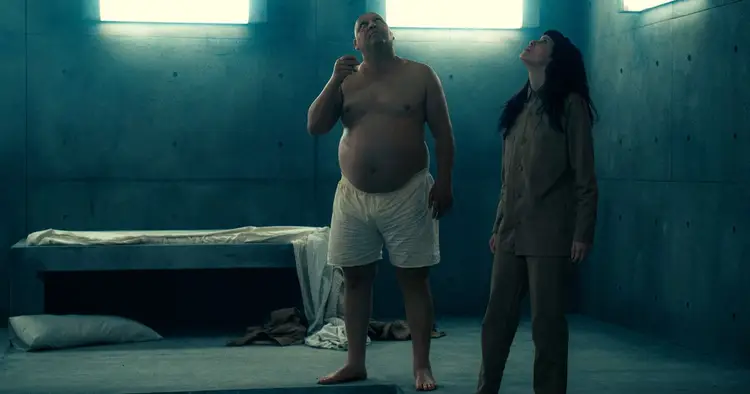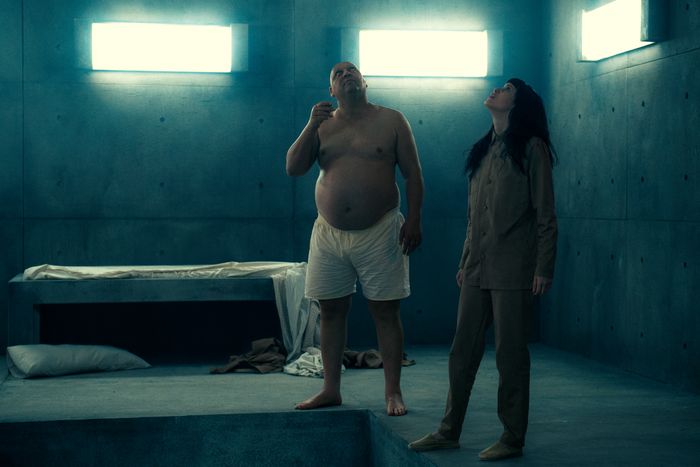Netflix ‘The Platform 2’ Review: Reheated and Not as Tasty

The Platform's Second Round Falls Flat
Written by A.A. Dowd, an independent editor and film reviewer.

Thought-provoking ideas are hard to come by in today's oversaturated content landscape, and that might explain the popularity of Galder Gaztelu-Urrutia's dystopian film, The Platform, which gained traction a few years ago. The Spanish thriller unfolds within a chillingly simple yet ruthless science-fiction premise, set entirely inside a futuristic prison — a tower made up of minimally furnished cells for two, referred to as a "Vertical Self-Management Center" but known among inmates as The Pit. The prisoners share a single meal served on a platform that descends through the building once a day, pausing at each level for only a short time. While the feast looks lavish on the upper floors, it quickly diminishes as it moves downward, leaving those at the bottom desperately searching for leftovers and scrapping for anything they can find. The film’s message is clear and powerful: we are all competing for the same limited resources. The Platform delivers a stark critique of capitalism that resonated even more during the height of the pandemic in the summer of 2020, when it broke streaming records on Netflix.
At what point does an intriguing concept start to feel stale? The Platform 2 certainly carries a sense of familiarity, as the original creative team revisits The Pit to explore the struggles of a new group of characters trapped in their own version of a survival competition. While the sequel does present some new ideas, both in terms of concepts and themes, such as modified rules in its bleak environment—a metaphorical representation of class struggle similar to a sideways Snowpiercer—it’s clear that this offering lacks the freshness and depth of the first installment.
The Platform concluded with a message of optimism, showcased by a child symbolically and literally rising from the depths of misery within the Pit. The story of Platform 2 seems to pick up from the consequences of that transformative moment, although the return of a familiar character raises questions about the timeline. In this new setting, each prisoner can select their meals for the day, but they must stick to their allotted portions. While food is still scarce, this approach is a fairer system, and a form of self-regulation has emerged, with Loyalists stepping in to keep the so-called Barbarians in check when they take more than their fair share, whether it's bread, pizza, cake, or fruits. Additionally, cannibalism is now banned, which is a significant setback for those below level 100, where the falling bodies might have been a more reliable food source than whatever leftovers remain by that stage.
Gaztelu-Urrutia, who was involved in both writing and directing The Platform 2, appears to be exploring the challenges of achieving a political ideal, regardless of its noble intentions. In this sequel, one of the new rules of The Pit states that if someone dies, their share of food cannot be consumed by others, even if they're on the brink of starvation, as that would be deemed unfair to the rest. But is it truly a fair system to waste food in the name of equality? While the first film critiqued how capitalism drives the 99 percent to turn against each other, the second installment seems to examine how socialist ideals can be distorted in practice. The antagonist isn't a nameless authority overseeing the prison; instead, it's a ruthless enforcer (Óscar Jaenada) who imposes the new rules of The Pit with brutal and disproportionate force. This raises the question: how many revolutions have seen the old regime replaced by a new form of tyranny?
The Platform 2 offers a lot to think about, at least for a bit. However, this time the film's symbolic themes lack an engaging storyline. Unlike the first film, which depicted a political awakening, the sequel revolves around an artist (Milena Smit) seeking personal redemption in the Pit. Her inevitable plunge into the depths of this hellish place, where hunger drives people to madness, serves mostly as a way for her to confront her own feelings—essentially a generic journey of self-forgiveness. This narrative feels like a diminished version of the original, which, while also addressing similar themes, had a broader focus rather than just one person's unresolved guilt.
In true sequel style, The Platform 2 serves up a lot of what fans expect, but this time it offers even more. The graphic violence is more intense, with digital heads and limbs flying in slow motion to an even greater extent. The fights—particularly the lengthy clash between the Loyalists and the Barbarians—are more savage and drawn-out. However, sometimes having more can actually be a drawback. As Gaztelu-Urrutia revisits the same concept and takes it in a familiar downward spiral, those who eagerly enjoyed the previous installment might find themselves feeling satisfied and ready to move on. Even thought-provoking ideas can lose their appeal when repeatedly reheated.









































